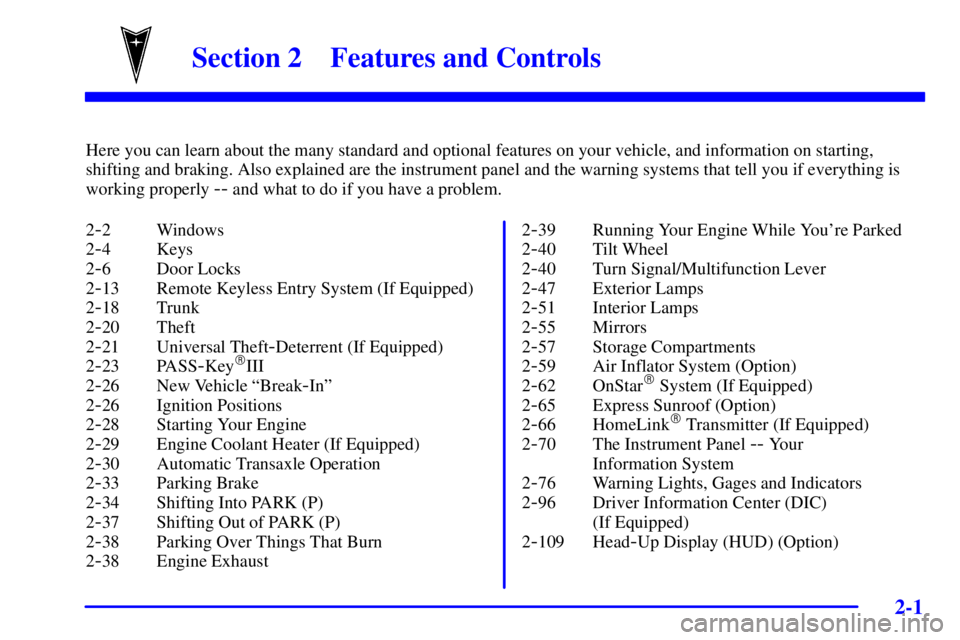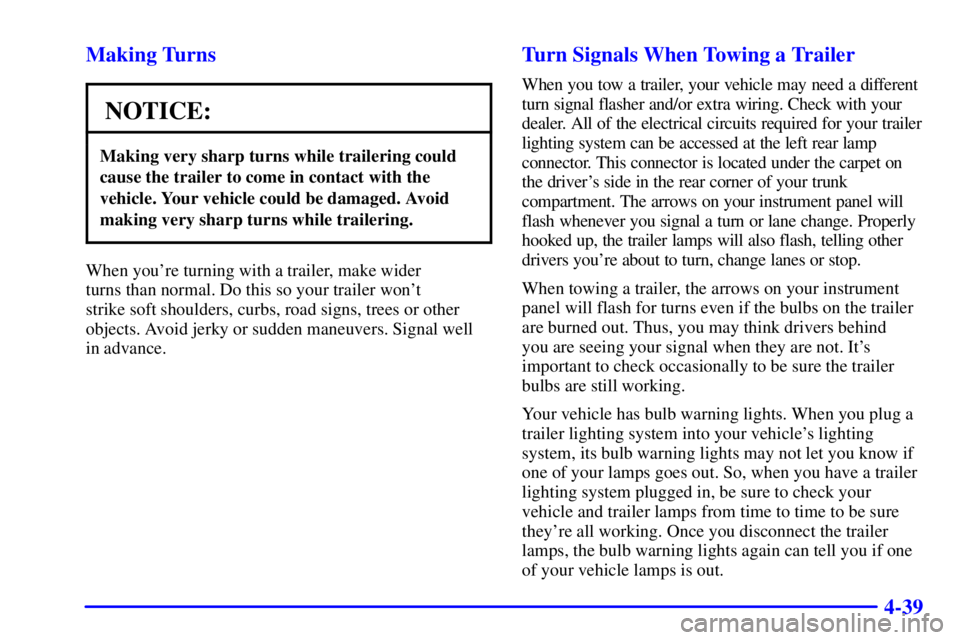Page 5 of 427

iv
Vehicle Damage Warnings
Also, in this book you will find these notices:
NOTICE:
These mean there is something that could damage
your vehicle.
In the notice area, we tell you about something that can
damage your vehicle. Many times, this damage would
not be covered by your warranty, and it could be costly.
But the notice will tell you what to do to help avoid
the damage.
When you read other manuals, you might see
CAUTION and NOTICE warnings in different
colors or in different words.
You'll also see warning labels on your vehicle.
They use the same words, CAUTION or NOTICE.
Vehicle Symbols
Your vehicle may be equipped with components and
labels that use symbols instead of text. Symbols,
used on your vehicle, are shown along with the text
describing the operation or information relating to a
specific component, control, message, gage or indicator.
If you need help figuring out a specific name of a
component, gage or indicator reference the following
topics in the Index:
�ªEngine Compartment Overviewº
�ªInstrument Panelº
�ªComfort Controlsº
�ªAudio Systemsº
Also see ªWarning Lights and Gagesº in the Index.
Page 64 of 427

2-
2-1
Section 2 Features and Controls
Here you can learn about the many standard and optional features on your vehicle, and information on starting,
shifting and braking. Also explained are the instrument panel and the warning systems that tell you if everything is
working properly
-- and what to do if you have a problem.
2
-2 Windows
2
-4 Keys
2
-6 Door Locks
2
-13 Remote Keyless Entry System (If Equipped)
2
-18 Trunk
2
-20 Theft
2
-21 Universal Theft-Deterrent (If Equipped)
2
-23 PASS-Key�III
2
-26 New Vehicle ªBreak-Inº
2
-26 Ignition Positions
2
-28 Starting Your Engine
2
-29 Engine Coolant Heater (If Equipped)
2
-30 Automatic Transaxle Operation
2
-33 Parking Brake
2
-34 Shifting Into PARK (P)
2
-37 Shifting Out of PARK (P)
2
-38 Parking Over Things That Burn
2
-38 Engine Exhaust2
-39 Running Your Engine While You're Parked
2
-40 Tilt Wheel
2
-40 Turn Signal/Multifunction Lever
2
-47 Exterior Lamps
2
-51 Interior Lamps
2
-55 Mirrors
2
-57 Storage Compartments
2
-59 Air Inflator System (Option)
2
-62 OnStar� System (If Equipped)
2
-65 Express Sunroof (Option)
2
-66 HomeLink� Transmitter (If Equipped)
2
-70 The Instrument Panel -- Your
Information System
2
-76 Warning Lights, Gages and Indicators
2
-96 Driver Information Center (DIC)
(If Equipped)
2
-109 Head-Up Display (HUD) (Option)
Page 90 of 427

2-27
ACC (Accessory): In this position you can operate your
electrical accessories such as power windows, sunroof
(option), audio system and windshield wipers.
ON: This is the position the switch returns to after you
start your engine and release the switch. Even when the
engine is not running, you can use ON to operate your
electrical accessories and to display some instrument
panel cluster warning lights. This is the position for
driving your vehicle.
START: This position starts the engine. When the
engine starts, release the key. The ignition switch will
return to ON for normal driving.
Even if the engine is not running, ACC and ON
are positions that allow you to operate your
electrical accessories.Key Reminder Warning
If you leave your key in OFF you will hear a warning
tone when you open the driver's door.
Retained Accessory Power (RAP)
After you turn the ignition off and remove the key, you
will still have power to such accessories as the radio,
sunroof (option) and power windows for up to
10 minutes. Power is turned off if you open a door.
Always leave your key in OFF. If you leave your key
in any position other than OFF, your battery will
discharge prematurely.
Page 135 of 427
2-72
Instrument Panel Clusters
The instrument panel clusters are designed to let you know at a glance how your vehicle is running. You'll know how
fast you're going, how much fuel you're using, and many other things you'll need to drive safely and economically.
Your vehicle is equipped with one of these instrument panel clusters, which includes indicator warning lights and
gages that are explained on the following pages.
Standard Cluster (United States version shown, Canada similar)
Page 139 of 427
2-76
Tachometer
The tachometer shows your
engine speed in revolutions
per minute (rpm).
NOTICE:
Do not operate the engine with the tachometer in
the shaded area or engine damage may occur.
Warning Lights, Gages
and Indicators
This part describes the warning lights and gages that
may be on your vehicle. The pictures will help you
locate them.
Warning lights and gages can signal that something is
wrong before it becomes serious enough to cause an
expensive repair or replacement. Paying attention to
your warning lights and gages could also save you or
others from injury.
Warning lights come on when there may be or is a
problem with one of your vehicle's functions. As you
will see in the details on the next few pages, some
warning lights come on briefly when you start the
engine just to let you know they're working. If you are
familiar with this section, you should not be alarmed
when this happens.
Page 140 of 427

2-77
Gages can indicate when there may be or is a problem
with one of your vehicle's functions. Often gages and
warning lights work together to let you know when
there's a problem with your vehicle.
When one of the warning lights comes on and stays on
when you are driving, or when one of the gages shows
there may be a problem, check the section that tells you
what to do about it. Please follow this manual's advice.
Waiting to do repairs can be costly
-- and even
dangerous. So please get to know your warning lights
and gages. They're a big help.
Your vehicle may also have a Driver Information Center
(DIC) that works along with the warning lights and
gages. See ªDriver Information Centerº in the Index.
The volume of your vehicle's warning chimes can be
adjusted. For more information see ªChime Level
Adjustmentº in the Index.
Safety Belt Reminder Light
When the key is turned to ON or START, a chime will
come on for about eight seconds to remind people to
fasten their safety belts.
The safety belt light will
also come on and stay on
for about 20 seconds, then
flash for about 55 seconds.
If the driver's belt is already buckled, the light will
come on briefly, but the chime will not sound.
Page 157 of 427

2-94
Systems Monitor (If Equipped)
If you have the systems
monitor, it gives you
important safety and
maintenance facts about
your vehicle.
When you turn the ignition on, the systems monitor and
warning lights will briefly light up. If a problem is
detected, the warning lights will turn on and a chime
will sound.The following warning lights are displayed in the
systems monitor:
�CHECK OIL LEVEL: This message could mean
your oil level is low. If it comes on for more than
five seconds, see ªCheck Oil Level Warning Lightº
in the Index.
�WASHER FLUID: This message means your
washer fluid tank is less than about 30 percent full. If
this light comes on, see ªLow Washer Fluid Warning
Lightº in the Index.
�DOOR AJAR: This message means that either the
driver's door or one of the passenger's doors is not
completely closed. If this light comes on, see ªDoor
Ajar Lightº in the Index.
�TIRE PRESS: This message means one or more of
your tires may be low. See ªCheck Tire Pressure
Systemº in the Index.
�CHECK GAGES: This means one or more of your
gages may be in their respective warning bands. If
this light comes on, see ªCheck Gages Warning
Lightº in the Index.
�TRUNK AJAR: This message means your trunk is
not completely closed.
Page 261 of 427

4-39 Making Turns
NOTICE:
Making very sharp turns while trailering could
cause the trailer to come in contact with the
vehicle. Your vehicle could be damaged. Avoid
making very sharp turns while trailering.
When you're turning with a trailer, make wider
turns than normal. Do this so your trailer won't
strike soft shoulders, curbs, road signs, trees or other
objects. Avoid jerky or sudden maneuvers. Signal well
in advance.
Turn Signals When Towing a Trailer
When you tow a trailer, your vehicle may need a different
turn signal flasher and/or extra wiring. Check with your
dealer. All of the electrical circuits required for your trailer
lighting system can be accessed at the left rear lamp
connector. This connector is located under the carpet on
the driver's side in the rear corner of your trunk
compartment. The arrows on your instrument panel will
flash whenever you signal a turn or lane change. Properly
hooked up, the trailer lamps will also flash, telling other
drivers you're about to turn, change lanes or stop.
When towing a trailer, the arrows on your instrument
panel will flash for turns even if the bulbs on the trailer
are burned out. Thus, you may think drivers behind
you are seeing your signal when they are not. It's
important to check occasionally to be sure the trailer
bulbs are still working.
Your vehicle has bulb warning lights. When you plug a
trailer lighting system into your vehicle's lighting
system, its bulb warning lights may not let you know if
one of your lamps goes out. So, when you have a trailer
lighting system plugged in, be sure to check your
vehicle and trailer lamps from time to time to be sure
they're all working. Once you disconnect the trailer
lamps, the bulb warning lights again can tell you if one
of your vehicle lamps is out.